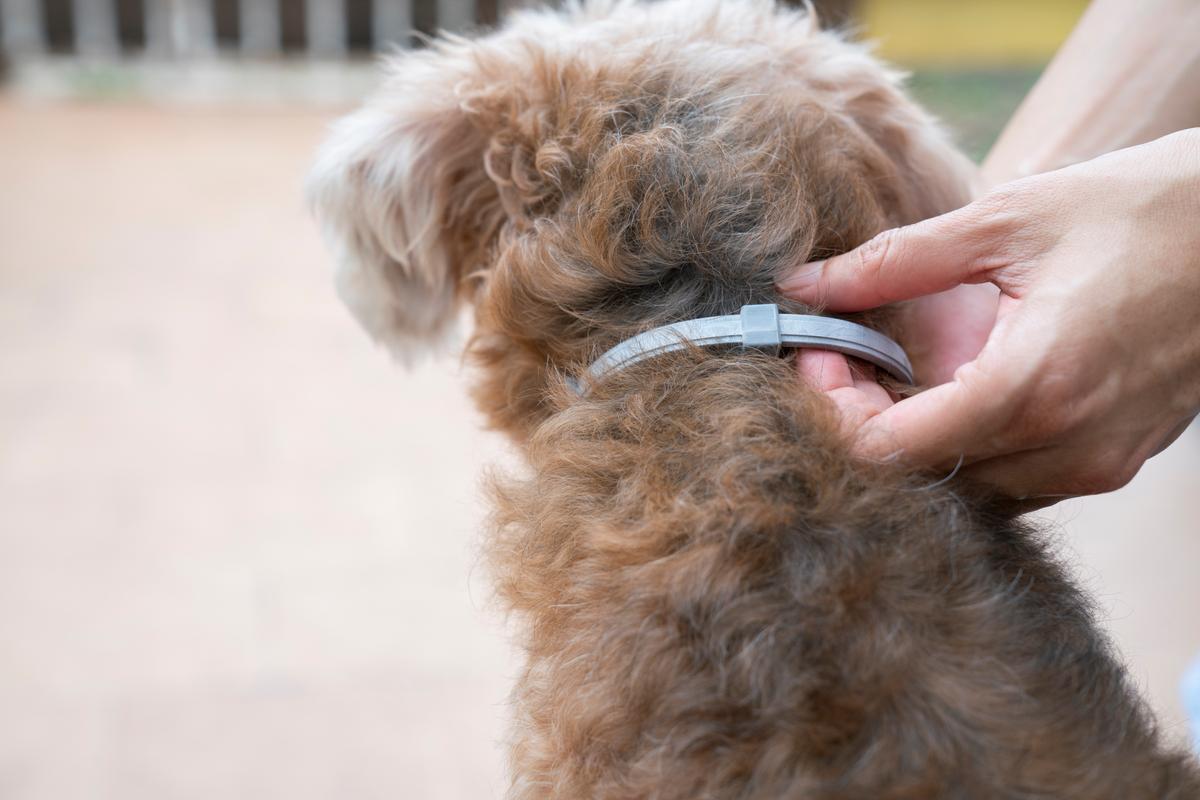When we think about man's best friend, we often picture fun moments in the park, a loyal companion by our side, and a playmate for the kids. What we don't imagine, however, are the tiny, pesky intruders known as fleas that can cause so much discomfort for our four-legged friends.
To combat these unwanted guests, many pet owners have turned to flea collars for dogs. They're a popular choice, but just how effective are they really? Let's dive in and find out.

Understanding Flea Collars
Before we explore the effectiveness of these flea-fighting devices, let's first understand what they are. A flea collar is a type of synthetic or natural repellant that is designed to keep fleas and ticks off your pet.
It's an inexpensive and hassle-free method that seems almost too good to be true. Just strap it on your dog's neck and voilà, no more scratching and itching.
However, with numerous products available in the market, it's crucial to know which ones really work and are worth your hard-earned money.
The Science Behind Flea Collars
Flea collars work by releasing active ingredients that repel or kill fleas. The collar's material acts as a reservoir, slowly emitting these substances onto your pet's skin and coat.
For instance, some flea collars utilize insecticides like Deltamethrin or Propoxur, which are designed to kill fleas on contact. Others use natural ingredients, like essential oils, to repel these pests.
Effectiveness of Flea Collars: What Does the Research Say?
While it's widely accepted that flea collars can help manage and prevent flea infestations, the extent of their effectiveness is influenced by multiple factors.
Studies suggest that modern flea collars can be extremely effective. According to research conducted by the School of Veterinary Medicine at Purdue University, some flea collars can kill up to 95% of fleas on your dog within the first few days of application.
However, their effectiveness can be influenced by your dog's size, age, breed, and environment. For instance, larger dogs might require more potent collars, while puppies need collars suitable for their sensitive skin. Some breeds may have thicker coats, making it harder for the collar to come into contact with the fleas. Environmental factors, like the level of infestation in your home or yard, can also affect the collar's performance.

Comparing Flea Collars: Choosing the Right One
Comparing different flea collars can feel like comparing apples and oranges, given the variety of options out there. However, understanding the key differences can guide you in making the right choice.
Seresto Flea and Tick Collar is a popular option that offers up to 8 months of protection. It uses two active ingredients, Flumethrin and Imidacloprid, that work together to repel and kill fleas.
For a natural alternative, the Only Natural Pet EasyDefense Flea & Tick Collar uses a blend of essential oils to repel pests. While it might not kill fleas as effectively as chemical collars, it's a good option for dogs with sensitive skin.
Safety of Flea Collars: Precautions to Take
While flea collars are generally safe, some dogs might react to them. Common side effects include skin irritation, redness, or swelling around the neck. In rare cases, the dog might experience vomiting, diarrhea, or lethargy.
If you notice any adverse reactions, remove the collar immediately and consult your vet. Always read the manufacturer's instructions before fitting a new collar. Also, remember that flea collars are not toys, so keep them out of reach of children and other pets.
Natural Flea Collars vs. Chemical Collars: The Battle Continues
When it comes to choosing between natural and chemical flea collars, there is no one-size-fits-all answer. Natural collars, while safer, might not be as effective as chemical collars in severe infestations. Chemical collars, on the other hand, can potentially cause side effects.
Ultimately, the choice depends on your dog's needs, your comfort level with using chemicals, and the severity of the flea problem.
Best Practices for Using Flea Collars
Here are some tips to ensure your flea collar works effectively:
- Fit the collar properly: It should be snug but not too tight. You should be able to slip two fingers between the collar and your dog's neck.
- Replace the collar as instructed: Most collars last for several months, but they may need replacing sooner if your dog is very active or frequently gets wet.
- Monitor for side effects: Keep an eye on your dog's behavior and physical condition, especially in the first few days after fitting a new collar.
Alternative Flea Treatments for Dogs
Flea collars are not the only line of defense against fleas. Other methods include oral medications, spot-on treatments, shampoos, and sprays.
Oral medications like NexGard or Comfortis are highly effective at killing fleas but require a vet's prescription. Spot-on treatments like Frontline Plus or Advantage II are applied directly to the dog's skin and can kill fleas at all life stages. Flea shampoos and sprays can provide immediate relief but may not offer long-term protection.
Each of these methods has its pros and cons, so it's essential to choose the one that best fits your dog's needs and lifestyle.

How Effective are Flea Collars?
Now that we understand the science behind flea collars, it's time to ask the big question: do they really work?
The short answer is yes, but it's not that simple. The effectiveness of flea collars depends on a variety of factors such as the type of collar, the active ingredients, the dog's size, breed, and age, as well as environmental factors.
Some flea collars are designed to repel fleas, while others aim to kill them on contact. A collar's success in fulfilling these tasks varies widely among products. Some collars can kill up to 90% of fleas within a few hours, while others may take a few days to start showing results.
Furthermore, effectiveness also depends on how infested your dog is and the lifecycle stage of the fleas. For instance, if a collar targets adult fleas but your pet's invaders are still in the larval stage, the collar's immediate effectiveness may appear low.
Comparing Flea Collars: A Closer Look
With countless flea collars available in the market, deciding which one to choose can be daunting. Let's dive deeper into this topic to help you make an informed choice.
When comparing flea collars, the first thing to consider is the active ingredient. Some collars use synthetic chemicals like Deltamethrin, Imidacloprid, or Flumethrin. These are potent insecticides that can kill fleas quickly. However, they might not be suitable for all dogs, especially those with sensitive skin or specific health conditions.
On the other hand, natural flea collars utilize essential oils such as citronella or eucalyptus to repel fleas. While they may be a safer option for your pet, they might not be as effective in heavy infestations or could require more frequent replacements.
In terms of duration, some flea collars promise protection for up to 8 months, which sounds fantastic for busy pet owners. However, this can also depend on the level of infestation and the dog's activity level. For example, a very active dog that loves swimming may need their collar replaced more frequently.
Safety of Flea Collars: Risks and Side Effects
While flea collars can be incredibly beneficial, they are not without risks, especially those containing powerful chemical insecticides. Some dogs might experience mild to severe adverse reactions to these collars.
The most common side effect is skin irritation, including redness, itching, and swelling at the site of the collar. In more severe cases, these reactions can escalate to hair loss or open sores.
More serious, albeit less common, health risks include gastrointestinal issues like vomiting or diarrhea. In rare cases, some dogs might display signs of nervous system problems, such as tremors, uncoordinated movements, and seizures.
If you observe any signs of discomfort or adverse reactions, it's essential to remove the collar immediately and consult with a veterinarian.
Natural Flea Collars vs. Chemical Collars: Weighing the Pros and Cons
When it comes to choosing between natural and chemical-based flea collars, there are a few factors to consider.
Natural flea collars generally use essential oils or herbs known to repel fleas. The advantage of these collars is that they present minimal health risks compared to their chemical counterparts, making them a safer choice for puppies, senior dogs, or dogs with health conditions.
However, natural flea collars may not offer the same level of protection as chemical collars. They primarily act as repellents rather than killers, meaning they may not be effective in the event of a severe infestation.
Chemical flea collars, on the other hand, typically provide more potent and comprehensive protection against fleas. They contain insecticides that not only repel but also kill fleas at various life stages. However, the downside is the potential health risks they pose, as discussed above.
Best Practices for Using Flea Collars
To maximize the effectiveness of flea collars while minimizing potential side effects, consider the following tips:
- Fit the collar correctly: The collar should be snug, but not too tight. Ideally, you should be able to fit two fingers between the collar and your dog's neck.
- Monitor your dog: Watch your dog closely for a few days after fitting the collar, especially if it's their first time using one. Look out for any changes in behavior or physical signs of discomfort.
- Replace as needed: Even if the collar claims to last for several months, consider replacing it sooner if your dog swims or bathes frequently, as water can reduce its effectiveness.
Alternative Flea Treatments for Dogs
Besides flea collars, several other flea treatment options might be more suitable, depending on your dog's specific needs.
Oral medications, such as Bravecto, work systemically to kill fleas. They are highly effective but require a vet's prescription.
Spot-on treatments like Advantage II or Frontline Plus are applied directly to the dog's skin, providing month-long protection against fleas at all stages.
Flea shampoos and sprays offer immediate relief from active infestations but might not provide long-term prevention.
Each treatment has its strengths and weaknesses, so the best option will depend on your dog's lifestyle, the severity of the infestation, and personal preferences.

Conclusion
When it comes to flea control in dogs, there are numerous options available, each with its own benefits and drawbacks. From spot-on treatments to shampoos and oral medications, it's crucial to choose a solution that aligns with your pet's specific needs and lifestyle. However, flea collars remain a convenient, long-lasting solution that offers unparalleled ease of use.
Regardless of the option you choose, it's essential to monitor your pet for any adverse reactions. If you observe any signs of discomfort or abnormal behavior, seek veterinary attention immediately.
Similarly, natural and chemical flea collars both have their place in pet care. While chemical collars often offer more robust protection, natural alternatives can be an excellent choice for pets with sensitive skin or for owners who prefer to avoid synthetic insecticides.

